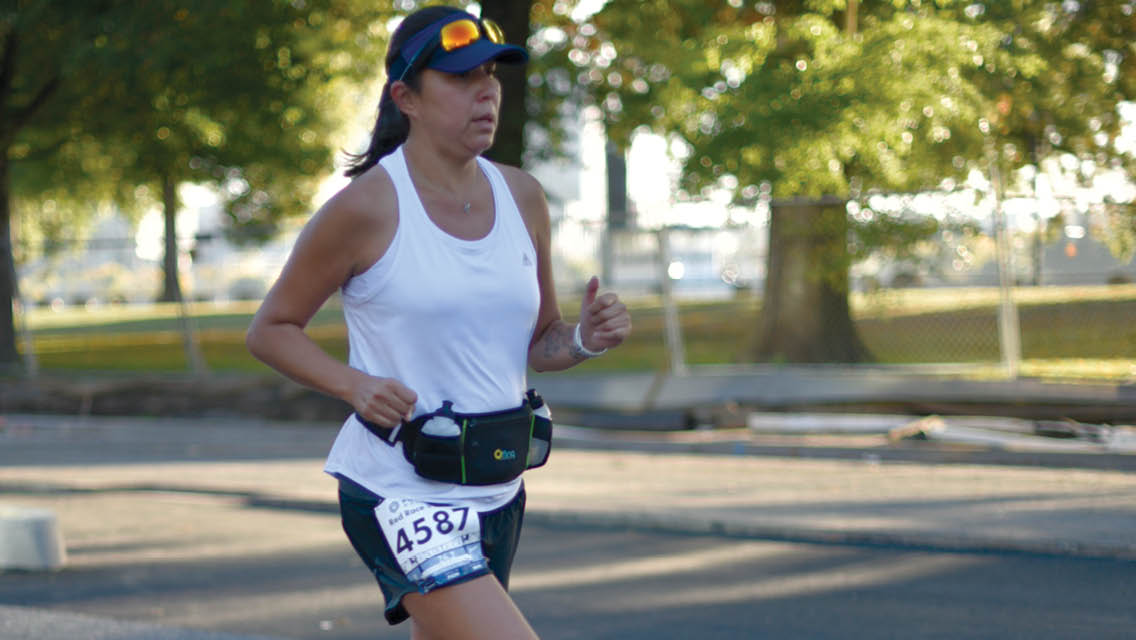The morning I was arrested in 2010, I was lying in bed with my dog, Ollie, whom I’d just adopted from a rescue shelter. I was 26 years old, an addict living in Hollywood, when federal marshals knocked at my door.
At the time, I was strung out, a heroin junkie who’d been struggling to get clean for four years. But addiction presented a challenge that my willpower alone could not overcome.
Meanwhile, my history of dealing had caught up with me — my arrest was related to drugs I’d sold years before in Maine.
It was later the morning of my arrest, as I was sitting handcuffed inside of an unmarked cruiser headed to a federal holding facility, that I felt my past collide with my (then-unknown) future. I had two distinct thoughts:
My life is over.
Thank God, at least that life is over.
If I could go back and talk to my 26-year-old self that day, I’d say, It’s all going to be OK. Even though I may not have listened or believed it then, I would try to convince myself that this was the best thing that could happen to me. It was the wake-up call I needed.
Escape
I grew up in Belfast, Maine, during the late 1990s and early 2000s, when aggressive promotion and increased prescribing of OxyContin triggered the opioid epidemic. Maine was one of the first places where the crisis took root, and drugs were commonplace when I was in high school.
Though I grew up in a loving home, generations of family trauma preceded me. Both of my parents’ families struggled with alcoholism and domestic dysfunction. This may have contributed to my own susceptibility to addiction.
Ever since I was a young adult, I’ve been drawn to experiences that allow me to escape the background noise in my head. As a child, you’re fully present and the world is magical — filled with possibility. Every experience is new and exciting; you can’t help but be fully immersed in the moment.
As you grow up, you start constructing your “self” and understanding your place in the world. You become aware of how the world perceives you: Other people, pressures, and responsibilities influence who you are and who you want to be. You start to experience fear and anxiety.
From early on, I sought spiritual outlets that helped me check out from all of that. I found that sports — particularly running and swimming — allowed me to be present in my body and experience each moment without fear and anxiety. Movement was comfort, and I became an accomplished high school athlete.
When I got older, I found that drugs also provided an escape, only they acted more quickly — no work required. Over time, I took advantage of this easy escape more often. I began selling drugs because it allowed me to continue using drugs.
My substance use during high school began to interfere with my athletic performance. I gave up running because it was hard to be a good miler when I was smoking every day. That was the first thing I loved that I sacrificed to addiction.
Sobering Experiences
As I progressed to harder drugs during my years at Wheaton College in Massachusetts, I continued to sell drugs to support my habit. For a while, I was a functioning addict; I kept up with my daily life even while I was using. I even continued to swim.
Yet my addiction progressed, and I ultimately failed my junior year for academic reasons, which is when things became dark. This was the lowest point of my journey. Previously, I’d been able to balance sports, school, and my addiction, but failing junior year was when I recognized that I was no longer in control of my life.
I made my first attempt at sobriety and managed to return to school. I stopped selling drugs, got a job, and finished college. After graduating, I moved to California, where I cycled in and out of addiction. Although I tried many times to get sober, I found that I was powerless to make any sustainable changes in my life.
That is, until I was arrested and sentenced to three years in prison for conspiracy to distribute cocaine. Before my trial, I realized that it was now or never: The time had come for me to get sober, and I was finally ready.
In prison, movement became a critical component of my recovery. Exercise had always been an activity I could turn to when I needed solace and confidence. This was especially crucial during the early days of my sobriety — I needed something I could count on, a reason to believe in myself again.
Also, my experience with endurance sports as a young athlete had taught me the value of structure, routine, consistency, and hard work. In prison, I learned I could apply these principles to other areas of my life, including my recovery.
Sober inmates were another great resource. They helped me learn how to ask for and seek out help. I still use this type of support system today.
From Training to Coaching
I was released from prison on January 28, 2014, and took a 62-hour bus ride to Portland, Maine, where I began to rebuild my life. At that point, I didn’t know what I wanted to do or what direction my life would take. I just knew I needed to do something to keep myself busy.
Because movement and exercise had become so important to me and my recovery, participating in endurance events seemed like a good place to start. The mystique and extreme nature of Ironman contests pulled me toward triathlon training.
I showed up day after day for training; I found comfort in consistency and routine. I researched what the world’s best athletes were doing and incorporated some of their ideas into my training.
Simultaneously, however, I was careful not to give 110 percent during any session — I didn’t want to lose myself ever again. I’d become better at recognizing when I needed to back off.
Once I started competing, I won a handful of Ironman 70.3s and was eventually ranked No. 1 in my age group in the United States and among the top 10 in the world. It felt great to be recognized, but I understood that internal joy doesn’t come from winning a race — that was all external. So, I was careful to avoid defining myself by my achievements.
In 2016, a job opportunity came up at a local fitness facility. It involved teaching cycling classes for triathletes in an interactive studio. I gave it a shot and realized I really enjoyed sharing my knowledge as part of a community of like-minded individuals. But it wasn’t until I met Matt Dixon of Purple Patch Fitness later that year that I had a true introduction to coaching.
Through Purple Patch, I started working with a wide range of athletes. Eventually, I became the head of programming and spent my days managing a team of coaches, writing programming for numerous products, and coaching individual athletes.
This type of work gave me a sense of purpose and aligned with what I was doing in recovery. After being so focused on myself and my addiction, it felt good supporting others as a coach in addition to participating in my local recovery community. I began to see how small actions in my life contributed to others’ successes, which helped build my sense of self-worth. Slowly, I started to redeem the self-esteem I had sold during my years of addiction.
Stepping Away
I began to reconsider my own role as a competitor in 2019. I still loved triathlons, but I realized I had unresolved issues with my self-worth and self-esteem, and I began to wonder whether I was using triathlons as another form of escape. I also noticed other similar patterns between my drive in sports and my addiction.
I asked myself how much of my motivation to compete stemmed from a desire to serve my ego and seek escape. And when I couldn’t answer that question, it really struck me. I could lose myself to endurance sports just as I’d lost myself to drugs.
Further, my priorities had shifted: I was now married, with a child on the way. I needed to conserve my time and energy for other areas of my life.
Endurance sports can be a healthy spiritual pursuit; I know they once were for me. Initially, training and competing helped me rediscover my needs, such as structure, consistency, and routine. They were invaluable tools supporting my journey of self-discovery and recovery. Maybe someday they will be again.
But I needed to step away from competitions. I needed to replace my ego with humility and think less about myself.
Knowing movement and exercise will always be important to me, I took the leap to focus on a new pursuit: After the 2019 World Championships, I sold all my equipment, left Purple Patch, and started my own coaching company.
Cultivating Presence and Peace
If endurance sports have taught me anything, it’s that it’s more about the journey — the pursuit of something hard and meaningful and the resulting lessons — than the outcome. For so long, I tried to numb my experience of this journey with drugs and endurance sports, but escape is no longer my goal. These days, it’s all about cultivating presence, contentment, and peace with my son, who was born in July 2020; with my relationships; with my family.
Today, I’m divorced, but my dog, Ollie (who stayed with my parents for the three years I was gone), still sleeps with me, and I take him for walks around my apartment complex in Louisville, Colo. The rest of the day, I’m coaching, spending time with my son, working out, attending recovery meetings, and reading.
Sometimes I reflect on how far I’ve come. It’s like I’ve lived two lives, the second of which started on the morning federal marshals arrived at my door. Though I couldn’t have known it then, that experience was the first step toward the life I’m living now — a life I want to live to the fullest.
Matthew’s Top 3 Success Strategies
- Create a routine. “Great is the enemy of good. Perfection is a myth and consistency wins over time — every time,” Matthew says. “One of my favorite quotes is ‘Only the disciplined are free.’ Structure provides that freedom.”
- Envision your “buckets” of life. For Matthew, these buckets are fitness, nutrition, spirituality, fun, family, and service.
- Embrace adversity. “How we deal with or face challenges is what defines our struggle as meaningful and having purpose or value,” Matthew says. (See “How Adversity Can Lead to Personal Growth.”
My Turnaround
For more motivating, real-life success stories of regular people who dropped excess weight, transformed their fitness, overcame obstacles, and changed their lives visit our My Turnaround department.
Tell Us Your Story! Have a transformational healthy-living tale of your own? Share it with us!
This article originally appeared as “Arrest & Recover” in the June 2023 issue of Experience Life.




This Post Has 0 Comments